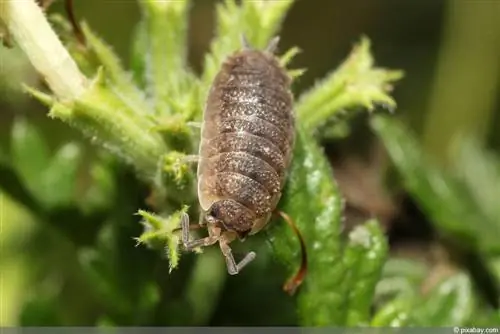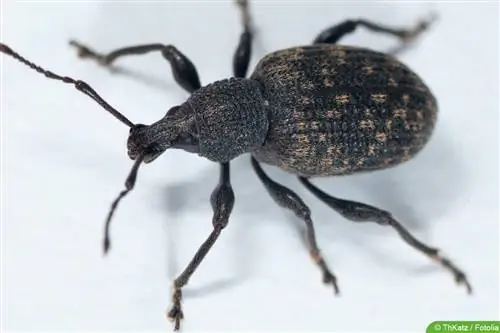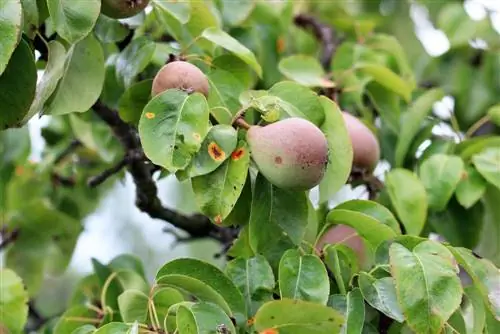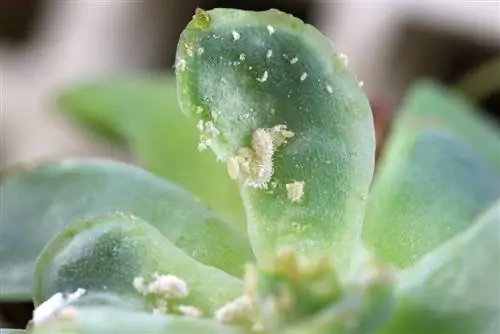- Author admin [email protected].
- Public 2023-12-17 03:39.
- Last modified 2025-06-01 06:48.
However, the woodlice will get out of hand if they are not decimated and are not exactly popular pets. They are also very active and use every possible crack to get from the garden or basement into the house. They are seen as disruptive or annoying, and although they don't actually harm anyone, some people are even afraid of them.
What to avoid when fighting
Sucking up the woodlice with a vacuum cleaner doesn't really help, because these little animals find enough food in the vacuum cleaner bag and continue to live happily there. Picking them up and putting them outside doesn't really do much good either, as you'll never find all the woodlice. Where there is one woodlice, there are usually more. An alternative is to kill the animals with chemical agents or to kill them with an object. The dead animals should then be disposed of immediately, as the corpses attract more woodlice. A fly screen on doors and windows only helps to a limited extent, as these little pests come in through all cracks in the house walls or through cracks in the beams. A trace of baking soda that is applied as a barrier to doors only helps to a limited extent, as it is possible that the woodlice in particular will enjoy this new nutritional supplement.
Natural remedies against woodlice
The most natural way is certainly to lay out rotten fruit and vegetables or fallen fruit. The animals then caught can be disposed of along with the waste. You can also make a hole in a large potato or turnip and hollow it out. The animals trapped inside can then be thrown away with the trash after a night. If you want to fight one evil with the other, you can attract frogs and mice. They love to eat woodlice and cats are also good woodlice hunters. They don't eat the woodlice, but they play with them until they die. Afterwards, however, the bodies must be removed immediately. Spirits poured into a bottle attract the woodlice, which then crawl into the bottle and are stunned. You can then dispose of the entire contents.
Where woodlice occur, sage leaves are also said to help. Simply spread a few leaves and the little annoying animals will be driven away. However, the best remedy against these little pests is absolute cleanliness. A floor free of dust and residue often prevents penetration into the house. Leftover food must be destroyed out of reach of the small animals and crumbs on the floor should be thrown in the trash immediately if possible. If you still discover a gap in the form of a crack in the house wall, it must be closed with filler.
If nothing helps - chemical agents
Poisonous agents in powder form or liquid are available commercially and these agents work very effectively. However, some products are harmful to humans and animals and anyone who has small children should not think about them at all. In addition to these products, there are cans that attract woodlice and kill them immediately, or in the same way, the woodlice are destroyed as much as possible with adhesive strips. However, the problem with clearing away remains here too, because the corpses have to be disposed of with any kind of chemical agent. For those experiencing severe infestations, an exterminator is the most convenient and effective solution to this type of problem.
The best remedy for woodlice - preventative measures
In addition to absolute cleanliness, avoiding waterlogging is a good preventative measure. Woodlice love moist, not wet, soil and for this reason feel particularly comfortable in cellars, compost heaps, bathrooms or sheds. For this reason, these rooms should be particularly well ventilated and waterlogging in corners should be prevented. Sealing cracks in the walls is also a preventative measure. Leaking pipes and loose floor tiles are also popular collection points for woodlice. Siliconizing the leaking or loose areas often helps.
These little animals can also often be found in plant pots that also smell musty or putrid. Therefore, when buying plant pots, balcony boxes and the like, make sure to drain the water and not to water the plants excessively. Close inspection of the plants for musty, rotten roots or plant parts and fresh, not wet soil are the best protection against woodlice in the house and garden. Waterlogging in pot saucers must be avoided at all costs and balcony flower boxes should always have a hole in the bottom so that excess water can drain away easily. Natural predators of the woodlice can work wonders in the garden, as the woodlice is the toads' favorite dish. In order to attract these predators, which also eat other pests, there must be piles of leaves, dense bushes, lushly planted ponds and hedges in the garden.
Cellar woodlice are incorrectly viewed as pests, but they ensure the disposal of rotten, organic substances of all kinds. In addition to the not entirely harmless toxins or traps, you can also use home remedies to combat these little animals. A hollowed-out potato or turnip, a bottle of spirits or laid out sage leaves help combat the pests. In all of these cases, however, the dead or stunned woodlice must be disposed of immediately. However, it is best to do something preventative. Dust- and residue-free soils, removal of all food residues, avoidance of waterlogging of soils or plants, removal of rotten or moldy leaves, flowers and roots from plants ensure that woodlice are not attracted in the first place.
What you should know about woodlice in brief
The woodlice belongs to the crustacean family. The harmless animals feed on moldy substances, are between 12 and 14 mm in size, gray in color and have a finely serrated and grainy carapace. They are mainly found in areas with increased humidity, including under stones, in cellars, gardens, stables, greenhouses and on compost heaps.
Prevention
- It makes sense not to create optimal conditions for the woodlice.
- So damp living spaces in the immediate vicinity of the house should be avoided.
- Cracks and crevices where water gets in can be sealed with silicone.
- Loose patio slabs and leaking water pipes should be eliminated.
- Flower pots and pots can be placed so that moisture does not accumulate at the bottom.
The animals are particularly interested in rotting plant material. If you want to deprive them of this source of food, you have to be very meticulous about keeping your borders and flower boxes in order. It's good when there is a common toad in the garden and has options for shelter. The amphibians are natural enemies of the woodlice and also ensure a decline in vermin in the garden. It's worth a try to scatter or lay out sage leaves in places where woodlice tend to frequent. The smell of the herb drives them away.
Remedies against woodlice
If woodlice can be found despite the measures mentioned, you usually cannot do without chemical agents. There are three types here:
- On the one hand, there are sticky traps. The animals stick to an adhesive surface. The traps are completely harmless to people and pets. They should be placed where the woodlice often stay.
- There are also special bait boxes. In addition to a bait substance that is attractive to woodlice, the cans contain an active ingredient that attacks the animals' nervous system and ultimately leads to their death.
- The last option is contact poisons. These are usually liquid or dusty preparations that can easily be applied to the animals' hiding places. There are a variety of products available in stores from various companies, so there is certainly something for every household use.
Home remedies
- Baking powder - a trace of baking powder as a block in front of doors should keep the animals away. That's rather doubtful, but it doesn't hurt either.
- Spirit of wine - Spirit of wine is said to attract bugs. They would crawl into the bottle and be drugged. Other alcoholic drinks are also said to help.
- Lay out attractants - place rotting fruit and vegetables in a targeted manner and wait until the woodlice attack them.
- Lay out adhesive strips (packing tape) - ideally around a bait
- Reduce air humidity - woodlice are gill breathers. That's why they can only survive where it's humid enough.
- Sage Leaves - Woodlice don't like the smell of sage, so putting out lots of leaves helps.






